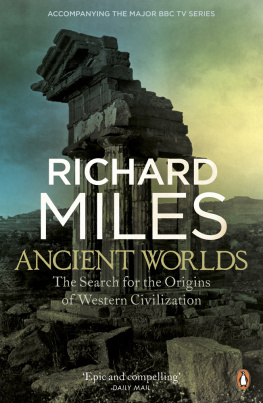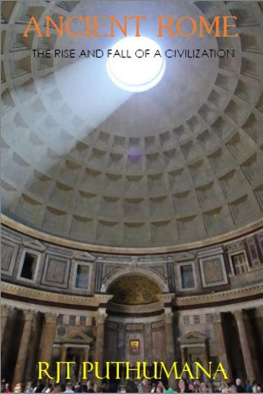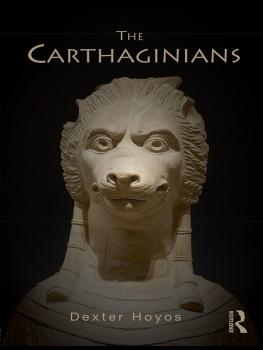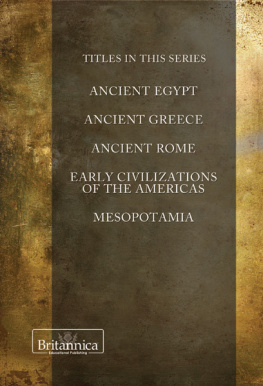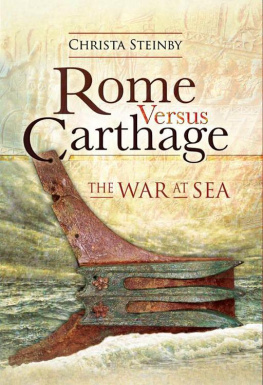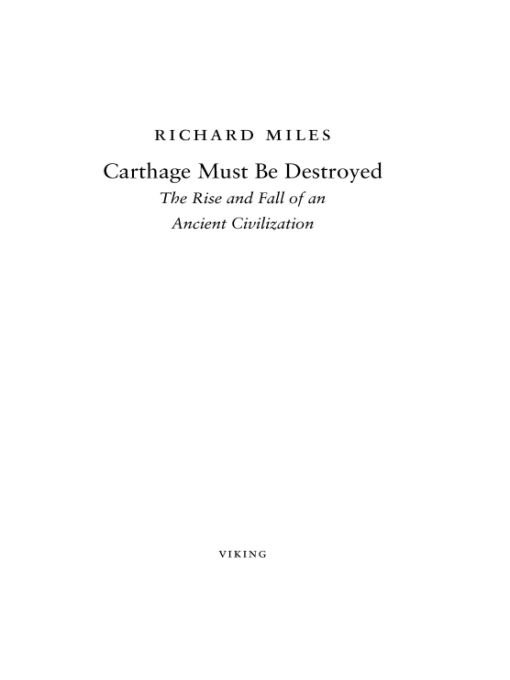Table of Contents
For my mother, Julie Miles
List of Illustrations
1. Aeneas Farewell from Dido in Carthage, 16756, oil on canvas, by Claude Lorrain, Hamburger Kunsthalle, Hamburg, Germany. Photograph copyright Elke Walford, 2005. Photo Scala, Florence/ BPK, Bildagentur fuer Kunst, Kultur und Geschichte, Berlin
2. Panoramic view of Carthage, painting, Muse National de Carthage, Tunisia. Prisma/Ancient Art & Architecture Collection Ltd
3. Finger ring with setting adorned with a womans head, third century BC, gold, from the Necropolis of sainte-Monique, Carthage. Muse National de Carthage, Tunisia. Photograph: Institut National du Patrimoine, Tunisie (INP)
4. Finger ring with setting adorned with the profile of a mans head, third century BC, gold, from the Necropolis of sainte-Monique, Carthage. Muse National de Carthage, Tunisia. Photograph: Institut National du Patrimoine, Tunisie (INP)
5. Amulets depicting faces, fourth to third century BC, glass, Muse National de Carthage, Tunisia. Photograph copyright Charles & Josette Lenars/CORBIS
6. Relief depicting the unloading of wood after transportation by sea, eighth century BC, stone, Assyrian, from the Palace of Sargon II, Khorsabad, Iraq. Muse du Louvre, Paris, France/Lauros/Giraudon/ The Bridgeman Art Library
7. Votive Punic stele depicting Priest holding a child, fourth century BC, dark limestone, from the tophet of Carthage. Muse National du Bardo, Tunisia. Photograph copyright Roger Wood/CORBIS
8. Punic stelae on the cemetery of the tophet, third to second century BC, Carthage, Tunisia. Photograph copyright Dave Bartruff/ CORBIS
9. Votive stele depicting Tanit, goddess of Carthage, holding a caduceus with a dolphin and an inscription, second to first century BC, limestone, Phoenician, from Tophet El-Horfa, Algeria. Muse du Louvre, Paris, France/The Bridgeman Art Library
10. Sarcophagus of Winged Priestess, fourth or third century BC, marble, from the Necropolis of sainte-Monique, Carthage. Muse National de Carthage, Tunisia. Photograph: Institut National du Patrimoine, Tunisie (INP)
11. Youth of Motya, c. 470450 BC, marble, Greek. Museo Giuseppe Whitaker, Mozia. Regione Siciliana, Soprintendenza per i Beni Culturali ed Ambientali, Servizio per i Beni Archeologici, Trapani. Copyright 2008. Photo Scala, Florence, Italy.
12. Gold sheet with Phoenician text, fifth century BC, from Pyrgi. Museo di Villa Giulia, Rome, Italy. Copyright 1990. Photo Scala, Florencecourtesy of the Ministero Beni e Att. Culturali.
13. Gold sheet with Etruscan text, fifth century BC, from Pyrgi. Museo di Villa Giulia, Rome, Italy. Copyright 1990. Photo Scala, Florence courtesy of the Ministero Beni e Att. Culturali.
14. Remains of a Phoenician ship, third century BC, Marsala, Italy. Copyright 1990. Photo Scala, Florence.
15. Stele of Amrit: Melqart on his lion, c. 550 BC, limestone, from Amrit, Syria. Muse du Louvre, Paris, France. Copyright RMN/ Franck Raux
16. Hercules, second century BC, bronze sculpture, Italian school, Palazzo dei Conservatori, Rome, Italy. Photograph copyright Araldo de Luca/CORBIS
17. Silver didrachm showing head of Hercules with she-wolf and twins design, Roman, issued c. 275260 BC. Photograph copyright The Trustees of the British Museum
18. Punic Mausoleum, early second century BC, Sabrata, Tripolitania, Libya. Photograph: akg-images, London/Grard Degeorge
19. Hannibal, first century BC, stone bust. Museo Archeologico Nazionale, Naples, Italy. Photograph: Mary Evans Picture Library
20. Silver double shekel of Carthage showing head of Hercules-Melqart, issued by the Barcid family in Spain, c. 230 BC. Photograph The Trustees of the British Museum
21. Snow Storm: Hannibal and his Army Crossing the Alps, exhibited 1812, oil on canvas, Joseph Mallord William Turner. Tate Gallery, London. Photograph copyright Tate, London 2009
22. The Battle of Zama, 202 BC, 1521, oil on canvas, attributed to Giulio Romano. The Pushkin State Museum of Fine Arts, Moscow, Russia. Photograph: akg-images, London
23. Scipio, Publius Cornelius, known as Scipio Africanus the Elder (235183 BC), marble bust, Roman. Musei Capitolini, Rome, Italy. Photograph: akg-images, London/Erich Lessing
24. Cato the Elder (234149 BC) in a toga, stone sculpture, Roman. Vatican Museums and Galleries, Vatican City, Italy/Alinari/The Bridgeman Art Libary
25. View of the ruins, Carthage, Tunisia. Photograph: Ken Welsh/The Bridgeman Art Library
26. Apotheosis of Alexandria with Personification of the Four Parts of the World (Or: Dido Abandoned by Aeneas), first century AD, mural painting, Roman, from Casa Meleagro, Pompeii, Italy. Museo Archeologico Nazionale, Naples. Photograph: akg-images, London/Erich Lessing
Every effort has been made to contact copyright holders. The publishers will be glad to correct any errors or omissions in future editions.
Chronology
All dates are BC
969936 Reign of Hiram I of Tyre.
Beginning of resurgence of Assyria.
884859 Reign of Ashurnasirpal II of Assyria.
830810 Foundation of Tyrian colony at Kition in Cyprus.
Reputed foundation date of Carthage.
800750 Foundation and early development of Carthage Foundation of Pithecusa.
800700 Foundation of Phoenician trading stations and colonies in Spain, the Balearics, Malta, Sardinia, Sicily and North Africa.
Reputed foundation date of Rome.
745727 Reign of Tiglathpileser III of Assyria.
704681 Reign of Sennacherib of Assyria.
586573 Siege of Tyre by Nebuchadnezzar, king of Babylon.
(circa) The Magonids come to dominate Carthage politically.
Victory of the Carthaginian and Etruscan fleets over the Phocaeans at Alalia.
First treaty between Carthage and Rome.
(circa) The Pyrgi Tablets.
500400 Possible period for Hannos voyage to West Africa and Himilcos expedition into the northern Atlantic.
Defeat of the forces of the Magonid general Hamilcar by Gelon, tyrant of Syracuse, at the Battle of Himera.
479410 Political reforms in Carthage, including creation of the Tribunal of One Hundred and Four, the Popular Assembly and the suffeture.
The destruction of Selinus and the recapture of Himera by Carthaginian forces.
Carthaginian protectorate in western Sicily acknowledged in a treaty with Dionysius of Syracuse.
The destruction of Motya by Dionysius of Syracuse and the subsequent foundation of Lilybaeum (Marsala) by the Carthaginians.
Introduction of the cult of Demeter and Core in Carthage.
390s380s The Magonids lose their political power base in Carthage.
Treaty between Carthage and Syracuse.
Second treaty between Carthage and Rome.
Syracusan forces under Timoleon defeat the Carthaginians at the Battle of the Crimisus.
New treaty between Carthage and Syracuse by which the dominion of Carthage in Sicily is confined to the lands west of the river Halycus (Platani).
Siege and capture of Tyre by Alexander the Great.
Death of Alexander the Great.
310307 Invasion of Punic North Africa by Agathocles of Syracuse.


